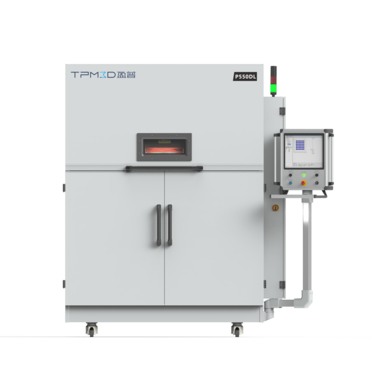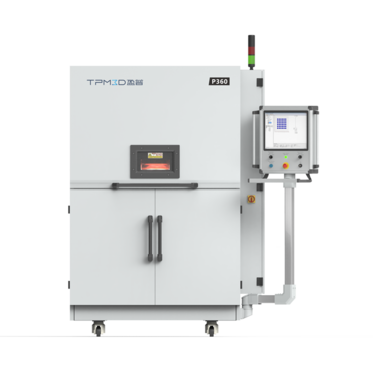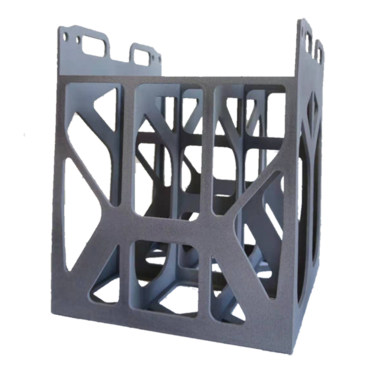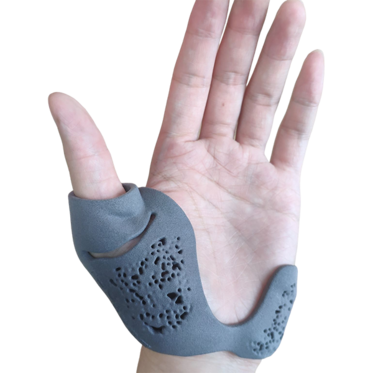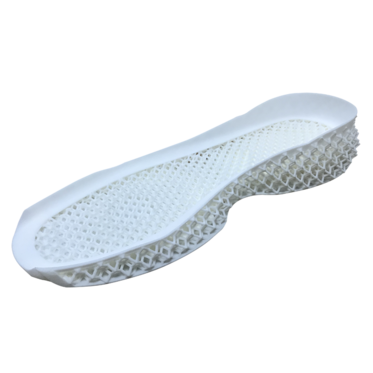With the development of 3D printing technology, more and more users are using it for product R&D as well as mass production. Although the application of 3D printing is becoming more mature, there are still some visible issues on the surface of the printed products, such as obvious layer lines and rough surfaces. Vapor smoothing and Vibration polishing are the main two post-processing ways to improve this. Now let’s take a look at the two methods’ comparisons.

Vapor Smoothing
Vapor Smoothing, also known as chemical vapor smoothing, is a technique that involves exposing printed parts to a solvent environment for surface treatment. In industrial vapor smoothing processes, individual or multiple parts are carefully suspended in an enclosed chamber to maximize exposure. A mixture of chemical solvents (such as FA 326) is injected and sprayed into the chamber where it condenses and hardens on the parts, eliminating surface irregularities through controlled melting. As the chamber temperature increases, residual solvent evaporates and is recovered. The final part becomes waterproof while retaining its smooth interior surfaces, precise dimensions, and original material volume.
To achieve optimal vapor smoothing results, it is recommended to use industrial-grade equipment specifically designed for 3D printing vapor smoothing in a controlled environment. For those interested in DIY methods, acetone or ethanol can be used as chemical solvents for achieving vapor smoothing. However, caution must be exercised and proper safety measures and equipment should be in place.

△ The left side is the vapor smooth section, and the right side is the standard surface treatment (Photo credit: ProtoLabs)
Vibration polishing
On the other hand, vibration polishing does not use chemicals for surface treatment. Instead, it relies on grinding media to enhance the surface of 3D printed parts. In this process, multiple 3D printed parts are placed in a vibrating bowl filled with selected grinding media and compound lubricant. When the machine is turned on, the bowl starts to move, creating mechanical friction between the parts and the grinding media. This subtractive process can minimize and gently remove the outer layer of material to improve the surface quality of the parts. Vibration polishing requires special measures and equipment and offers two methods: vibration method and tumbling method. The vibration method is particularly suitable for larger objects with fewer details and can achieve desired results faster.
The selection of abrasives or chips is crucial in vibration polishing. Abrasive fragments can be made with ceramics,plastics, or steel, each producing different results. Ceramic abrasives are especially effective in removing burrs and achieving a bright surface finish. Due to their high density, they can withstand high pressure and are suitable for processing stainless steel, metal, and plastic parts. Plastic abrasives are ideal for gentle processing of soft delicate surfaces.They come in pyramid shape or conical shape varieties.Additionally,Walther Trowal has also developed nipple-shaped abrasives that are suitable for ultra-small delicate parts in hard-to-reach areas.Steel shot abrasive mostly have spherical shape imparting minimal material removal making them particularly suited for polishingand mechanical cleaning of metal,silveror aluminum-made parts ensuring smooth scratch-free surfaces.

△Ceramic-based abrasives can withstand high pressure.(Source: Vibrafinish)
In addition to abrasives, lubricants, also known as compounds, are needed. These compounds are used to absorb and remove wear on parts, as well as clean and degrease them. For processing metal parts, acidic compounds can be used for pickling. After treatment, drying is required. The parts can be placed in a vibratory dryer for drying along with heated drying media such as corn cob grits, walnut shell grits or wood chunks.
Compatible Materials
Vapor smoothing is compatible with most 3D printing polymers and elastomers. Common materials suitable for vapor smoothing include Acrylonitrile Styrene Acrylate (ASA), Acrylonitrile Butadiene Styrene (ABS), High-Impact Polystyrene (depending on the machine), Nylon 11 (PA 11), Nylon 12 (PA 12), Polypropylene (PP), and Polycarbonate/Acrylonitrile Butadiene Styrene (PC-ABS). However, it should be noted that TPU and certain specialty filaments are not recommended for vapor smoothing. Each solvent such as acetone, methyl ethyl ketone (MEK), tetrahydrofuran(THF), dichloromethane(DCM) and ethyl acetate has its own effectiveness and application considerations.
On the other hand, vibrationpolishing is compatible with many different materials. For example,vibration polishing can be used not only for 3D printed parts made with thermosetting plastics ,thermoplastic plastics,and elastomers(such as polyethylene(PE),polypropylene(PP)or polyethylene terephthalate(PET)),but also for metals such as aluminum,stainless steel,copper or brass.This makes it a more versatile method that can be used as a post-processing technique for various 3D printing technologies like FDM/FFF and powder bed fusion.

△Before and after comparison of metal parts treated by vibration polishing (Source: Acton Finishing)
Limitations and Advantages of Post-processing Techniques
Both methods have many advantages in terms of surface appearance and performance. Vapor smoothing can achieve surfaces that are as smooth and waterproof as injection molded parts, while also improving elongation, tensile strength, bending performance, maintaining characteristics, strength, and accuracy of the parts. On the other hand, vibrattion polishing cannot achieve waterproof but it can provide exceptionally smooth surfaces by removing coating marks and producing scratch-resistant and dirt-repellent surfaces. Parts processed using vibration polishing and vapor smoothing methods can produce glossy-looking smooth surfaces. However, compared to vibration polishing, vapor smoothing provides a shinier surface. Additionally, parts treated with vibration polishing exhibit noticeably softer and more pleasant tactile experience.
On the other hand,vibrattion polishing is suitable for a wider range of 3D printed parts than vapor smoothing because it can adapt to any personalized requirements ,material properties, and structures by choosing different abrasives/methods .As long as this process is always performed professionally by experts, vibration polishing applies almost all 3D printed components.However vibraotry finshing might result in loss of geometric shape for certain components.For example,the angles and tips of a component may become overly rounded and lose their shape,which does not occur with vapor smoothing. Additionally, vibration polishing sometimes requires further drying procedures afterwards which prolongs the process.
Application Fields
vapor smoothing is a favored technology in industries such as medical, automotive, and aerospace for treating waterproof, antibacterial parts without chemical substances. When it comes to vibration polishing, the medical, automotive, and sports industries particularly benefit via this technique. In each field,a smooth surface(particularly metallic components)is critical to ensure proper operation and safety conditions of parts.However both vapor smoothing and vibration polishing can be implemented throughout the product development cycle turn concept models to prototypes to final products,and have been widely used in various industries including medical, automotive,and consumer goods.For example,parts processed using vibration polishing techniques include automotive parts or sporting equipment like ice skates or fitness equipment.Additionally,jewelry and cutlery are also polished using vibration polishing techniques for consumer use.An example in the automotive industry where vapor smoothed components are frequently used is internal components of vehicles,such as dashboards ,door handles,and center console elements. vapor smoothing is also used for aircraft parts in the aerospace industry,such as wings,air ducts ,and engine components.

△ vapor Smoothing commonly applied on aircraft parts in Aerospace Industry (Image source: Fast Radius)
The suppliers and the prices
Different service providers, such as SPALECK GmbH, VibraFinish, or Rohde AG, offer vibration polishing services for private customers and companies. For vapor smoothing, well-known service providers include Xometry, AMT, DyeMansion, Protolabs, and Hubs. They provide vapor smoothing services through designated post-processing solution machines or based on material specifications. 3Faktur is a German company that offers both vapor smoothing and vibration polishing services. Popular vapor smoothing machines like the AMT PostPro3D series and Powerfuse S series are provided by Xometry and DyeMansion respectively. Protolabs and Hubs use SLS (Selective Laser Sintering) technology with MJFHPA 12 (Multi Jet Fusion High-Performance PA 12), PA 12 (Polyamide 12), MJF Ultrasint™TPU-01 materials.
As for vibration polishing large industrial machines produced by manufacturers like Walther Trowal AVATec or Garant have prices ranging $18k to $21k USD (€17k to €20k). The price of a 2kg abrasive ranges $21 to $44 USD (€20 to €40), while a compound of 5 liters costs approximately the same ($21 - $44 USD/€20 - €40). Prices can vary significantly depending on the quantity and size of the parts to be processed. For vapor smoothing services, the cost per part can range $5 up to $15 USD ($4 - €14) depending on complexity; although many manufacturers typically only offer this service in bundles of at least ten parts. The cost of purchasing a vapot smoothing device itself is around $10k to $30k USD (€11k - €33K), depending on region, manufacturer,and quality level.



